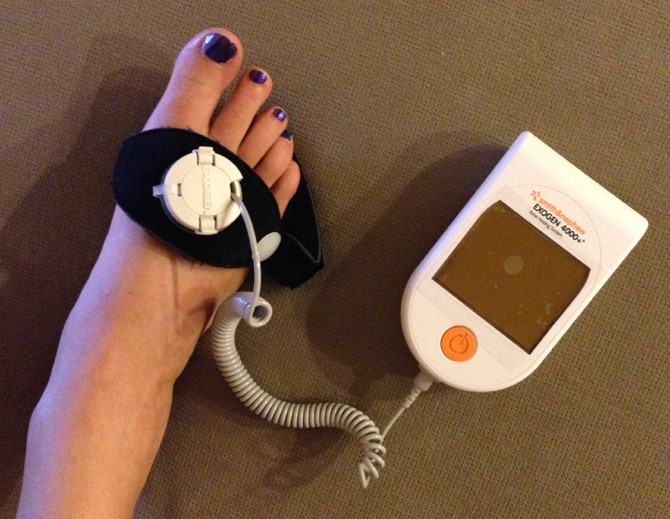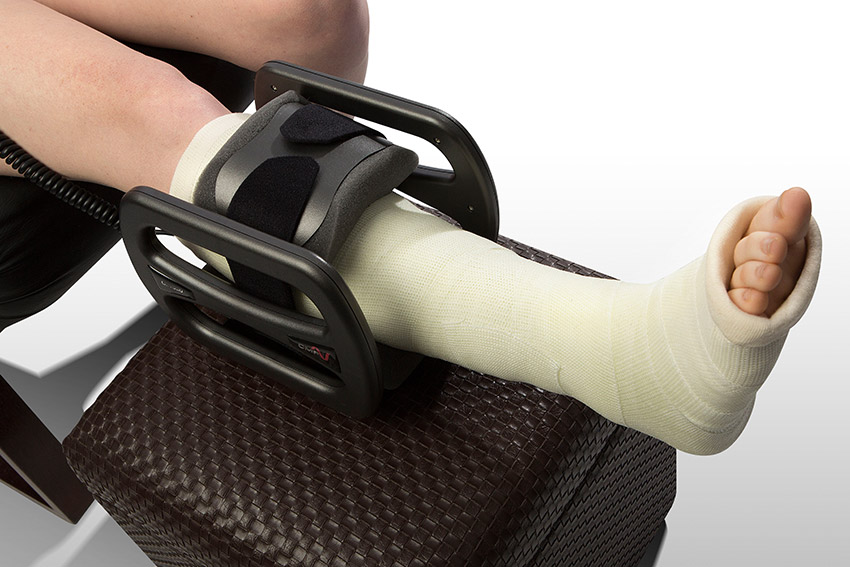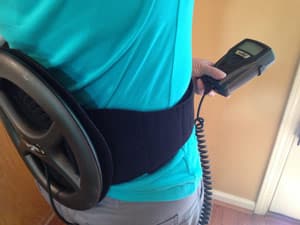What is a Bone Stimulator for Foot?
A bone stimulator for foot is a non-invasive medical device that promotes bone growth and healing. It is designed to treat foot injuries and conditions that require enhanced bone repair, such as stress fractures, delayed union, and non-union fractures. The device works by emitting electrical or ultrasound waves that stimulate bone cells and enhance the natural healing process. By doing so, bone stimulators for foot can help reduce pain, speed up recovery, and minimize the risk of complications.
How Does a Bone Stimulator for Foot Work?
Bone stimulators for foot work by utilizing the body’s natural healing process to promote bone growth and repair. The device emits electrical or ultrasound waves that stimulate bone cells, known as osteoblasts, to increase their activity and production of new bone tissue. This enhanced cellular activity results in faster healing times and improved bone density. Electrical bone stimulators for foot work by sending a low-level electrical current through the affected area, which creates a small electrical field. This field stimulates the osteoblasts to produce new bone tissue and helps to align the bone fragments in the correct position. Ultrasound bone stimulators, on the other hand, use high-frequency sound waves to create a micro-vibration that stimulates the osteoblasts and promotes bone growth.
Both types of bone stimulators for foot are non-invasive and can be used in conjunction with other treatments, such as casts, braces, or surgery. They are typically used for foot injuries that are slow to heal or have a high risk of non-union, such as stress fractures, delayed union, and non-union fractures. By promoting bone growth and repair, bone stimulators for foot can help to reduce pain, speed up recovery, and minimize the risk of complications.
Common Foot Conditions Treated with Bone Stimulators
Bone stimulators for foot are commonly used to treat a variety of foot conditions that involve bone injuries or damage. Some of the most common foot conditions treated with bone stimulators include:
- Stress fractures: Small cracks in the bones of the foot that can occur due to overuse or repetitive stress, such as in athletes or dancers.
- Delayed union: A condition where the bones take longer than usual to heal after a fracture, often due to poor blood supply or other factors.
- Non-union fractures: A condition where the bones do not heal at all after a fracture, often requiring surgical intervention or other treatments.
- Avascular necrosis: A condition where the bone tissue dies due to lack of blood supply, often requiring bone grafting or other surgical procedures.
- Spinal fusion surgery: A surgical procedure where bone grafts are used to fuse two or more vertebrae in the spine, often requiring the use of a bone stimulator to promote bone growth and fusion.
By promoting bone growth and repair, bone stimulators for foot can help to reduce pain, speed up recovery, and minimize the risk of complications in these and other foot conditions.
Benefits of Using a Bone Stimulator for Foot
Bone stimulators for foot offer several benefits for individuals suffering from foot injuries and conditions. Some of the key benefits of using a bone stimulator for foot include:
- Faster healing: Bone stimulators for foot can help to speed up the healing process by stimulating bone cells and enhancing the natural healing process. This can result in a faster recovery time and a quicker return to normal activities.
- Reduced pain: By promoting bone growth and repair, bone stimulators for foot can help to reduce pain and discomfort associated with foot injuries and conditions. This can improve the individual’s quality of life and overall well-being.
- Minimized risk of complications: Bone stimulators for foot can help to minimize the risk of complications, such as infection or non-union, in foot injuries and conditions. This can result in a more successful treatment outcome and a lower risk of long-term complications.
- Non-invasive: Bone stimulators for foot are non-invasive, meaning they do not require surgery or other invasive procedures. This can result in fewer risks and side effects, as well as a faster recovery time.
- Cost-effective: Bone stimulators for foot can be a cost-effective treatment option for foot injuries and conditions. While the upfront cost of the device may be higher than other treatments, the long-term benefits and reduced risk of complications can result in lower overall healthcare costs.
Overall, bone stimulators for foot offer a safe, effective, and non-invasive treatment option for foot injuries and conditions. By promoting bone growth and repair, reducing pain and discomfort, and minimizing the risk of complications, bone stimulators for foot can help individuals to recover faster and improve their overall quality of life.
Top Bone Stimulators for Foot in the Market
When it comes to choosing the right bone stimulator for foot, there are several top-rated options available in the market. Here are some of the best bone stimulators for foot that you can consider:
EXOGEN Ultrasound Bone Healing System
The EXOGEN Ultrasound Bone Healing System is a popular bone stimulator for foot that uses low-intensity pulsed ultrasound (LIPUS) technology to stimulate bone growth and healing. It is a portable and easy-to-use device that can be used at home or in a clinical setting. The EXOGEN system has been clinically proven to accelerate bone healing and reduce the risk of non-union in foot fractures. It is FDA-cleared and covered by most insurance plans.
Ossatek Bone Growth Stimulator
The Ossatek Bone Growth Stimulator is another top-rated bone stimulator for foot that uses non-invasive electrical stimulation to promote bone growth and healing. It is a comfortable and easy-to-use device that can be worn under clothing for discreet use. The Ossatek stimulator has been shown to improve bone density and reduce the risk of non-union in foot fractures. It is FDA-cleared and covered by most insurance plans.
Samson Rutherford Bone Stimulator
The Samson Rutherford Bone Stimulator is a compact and portable bone stimulator for foot that uses low-intensity pulsed ultrasound (LIPUS) technology to stimulate bone growth and healing. It is a user-friendly device that can be used at home or in a clinical setting. The Samson Rutherford system has been shown to accelerate bone healing and reduce the risk of non-union in foot fractures. It is FDA-cleared and covered by most insurance plans.
Zimmer MedizinSystems Bone Growth Stimulator
The Zimmer MedizinSystems Bone Growth Stimulator is a high-quality bone stimulator for foot that uses non-invasive electrical stimulation to promote bone growth and healing. It is a comfortable and easy-to-use device that can be worn under clothing for discreet use. The Zimmer MedizinSystems stimulator has been shown to improve bone density and reduce the risk of non-union in foot fractures. It is FDA-cleared and covered by most insurance plans.
When choosing a bone stimulator for foot, it is important to consider factors such as the type of injury, the size and shape of the device, the ease of use, and the cost. It is also recommended to consult with a healthcare professional to determine the most appropriate bone stimulator for your specific needs and condition.
How to Choose the Right Bone Stimulator for Foot
When it comes to choosing the right bone stimulator for foot, there are several factors to consider. Here are some tips to help you make an informed decision:
- Type of injury: Different bone stimulators are designed to treat specific types of injuries. For example, some bone stimulators are better suited for treating stress fractures, while others are more effective for non-union fractures. Make sure to choose a bone stimulator that is designed to treat your specific type of injury.
- Size and shape: Bone stimulators come in various sizes and shapes. Some are small and portable, while others are larger and require a power source. Consider the size and shape of the bone stimulator and choose one that is comfortable and easy to use. If you plan to use the bone stimulator at home, choose a portable and lightweight device that you can easily carry around.
- Ease of use: Bone stimulators can be complicated to use, especially for those who are not familiar with medical devices. Look for a bone stimulator that is easy to use and comes with clear instructions. Some bone stimulators come with user-friendly features such as touch screens, voice commands, and automatic shut-off.
- Cost: Bone stimulators can be expensive, and the cost can vary depending on the type and brand of the device. Consider your budget and choose a bone stimulator that is affordable and offers good value for money. Keep in mind that some insurance plans cover the cost of bone stimulators, so check with your insurance provider to see if you are eligible for coverage.
- Clinical evidence: Look for a bone stimulator that has clinical evidence to support its effectiveness. Check if the device has been approved by regulatory agencies such as the FDA and if it has been tested in clinical trials. Choose a bone stimulator that has a proven track record of success and is recommended by healthcare professionals.
By considering these factors, you can choose the right bone stimulator for foot that meets your needs and helps you recover from your injury faster. Remember to consult with a healthcare professional before using any medical device, including bone stimulators, to ensure that it is safe and appropriate for your specific condition.
How to Use a Bone Stimulator for Foot
Using a bone stimulator for foot is a straightforward process that can be done at home or under the supervision of a healthcare professional. Here are the steps and precautions for using a bone stimulator for foot:
- Frequency and duration: The frequency and duration of the treatment depend on the type and severity of the injury. In general, bone stimulators for foot are used for 20 to 30 minutes a day, once or twice a day, for several weeks or months. Follow the instructions provided by the manufacturer or your healthcare provider regarding the frequency and duration of the treatment.
- Placement and alignment: Place the bone stimulator on the affected area of the foot, following the instructions provided by the manufacturer or your healthcare provider. Make sure that the device is properly aligned with the bone and that there is good contact between the device and the skin. Move the device gently to ensure that it covers the entire affected area.
- Monitoring and evaluation: Monitor the affected area for signs of healing, such as reduced pain, increased mobility, and improved bone density. Keep a record of the treatment sessions and any changes in the affected area. Share this information with your healthcare provider to evaluate the progress of the healing process.
- Precautions: Do not use a bone stimulator for foot if you have a pacemaker, implanted electrical device, or metal implant in the affected area. Do not use the device if the skin is irritated, infected, or damaged. Follow the instructions provided by the manufacturer or your healthcare provider regarding the use of the device, including cleaning and maintenance.
By following these steps and precautions, you can use a bone stimulator for foot safely and effectively. If you have any questions or concerns about using a bone stimulator for foot, consult with a healthcare professional.
Potential Risks and Side Effects of Bone Stimulators for Foot
While bone stimulators for foot are generally safe and effective, there are some potential risks and side effects to be aware of. Here are some of the most common risks and side effects, along with some safety tips and recommendations for minimizing these risks:
- Skin irritation: Some people may experience skin irritation or redness at the site where the bone stimulator is applied. To minimize this risk, make sure to clean the skin thoroughly before applying the device, and avoid using any lotions, creams, or ointments that may interfere with the adhesive. If you experience skin irritation, discontinue use and consult with a healthcare professional.
- Infection: There is a small risk of infection associated with the use of bone stimulators for foot. To minimize this risk, follow the instructions provided by the manufacturer or your healthcare provider regarding cleaning and maintenance of the device. If you experience any signs of infection, such as redness, swelling, or pus, discontinue use and consult with a healthcare professional.
- Nerve damage: In rare cases, the use of bone stimulators for foot may cause nerve damage or other neurological symptoms. To minimize this risk, follow the instructions provided by the manufacturer or your healthcare provider regarding the placement and alignment of the device. If you experience any numbness, tingling, or other neurological symptoms, discontinue use and consult with a healthcare professional.
In general, bone stimulators for foot are safe and well-tolerated. However, it is important to follow the instructions provided by the manufacturer or your healthcare provider, and to discontinue use and consult with a healthcare professional if you experience any adverse effects. By taking these precautions, you can use a bone stimulator for foot safely and effectively, and promote bone growth and healing in a non-invasive and convenient way.








